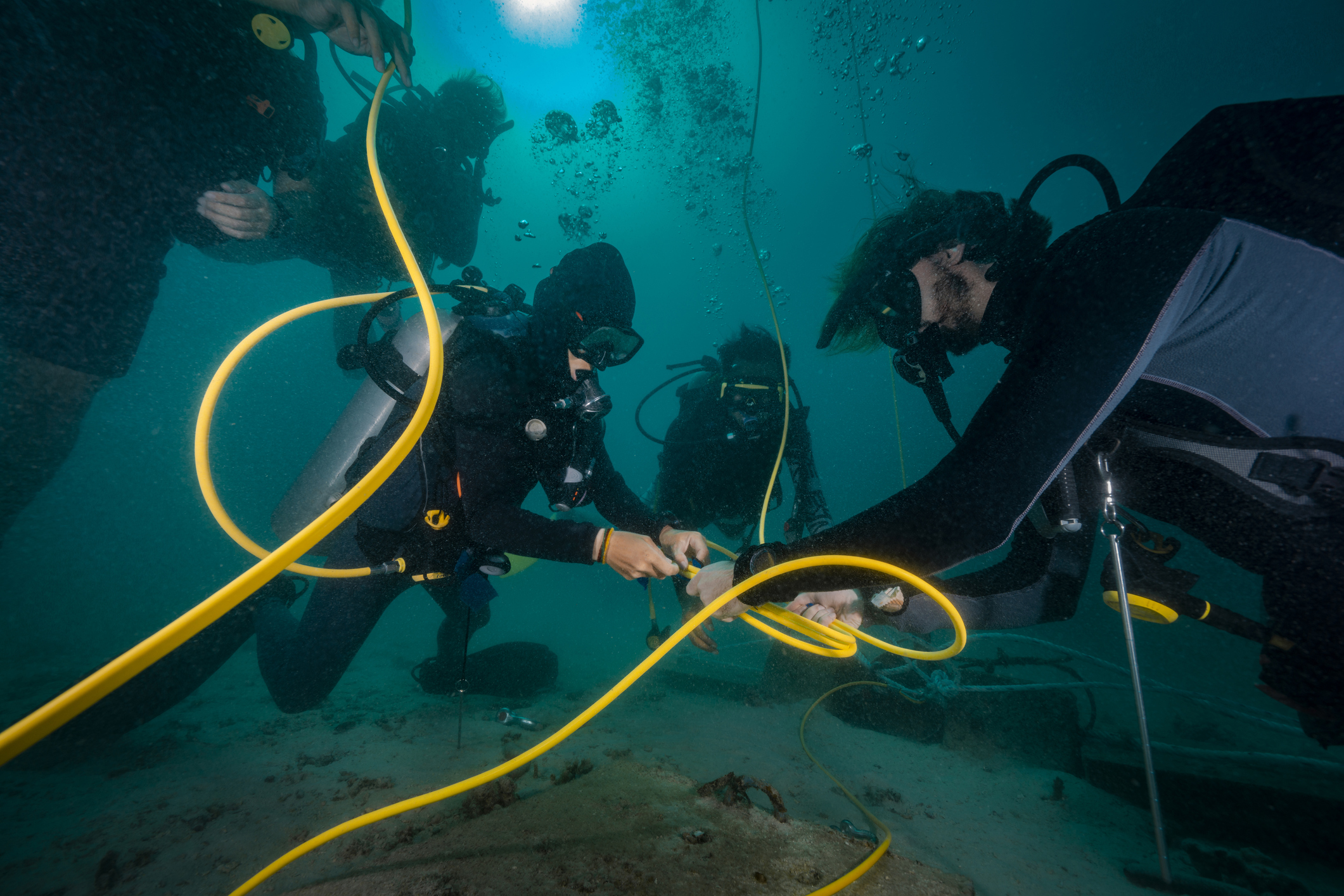How investors can cash in on undersea cables
Undersea cables are in demand as the renewable energy boom has sparked a race to rewire the world


Markets dominated by an oligopoly of firms are rare. Those dominated by an oligopoly with over a decade of revenue visibility are even rarer. So when they appear, investors should leap at the chance. Such an opportunity exists in the large ultra-high-voltage cable market. The market for these cables has become dominated by a handful of European firms.
Over the past decade, these companies have crafted a competitive advantage, flying under the radar of regulators and competitors in a relatively boring and overlooked industry. In fact, the industry barely existed a decade ago. However, it is now growing at such a rate that these firms have accumulated order backlogs into the next decade, and there is no sign of demand slowing down before the late 2030s.
Why undersea cables are in demand
The energy transition is the biggest economic and investment trend in the world today. It is likely to endure for the next two decades as the world rewires itself and builds the infrastructure required to move away from fossil fuels. One of the key challenges of the transition is the process of moving energy from place to place. In the world of fossil fuels, moving energy is relatively easy (or it is now the world has been doing it for so long). Energy stored in oil and gas is transported by moving the commodity via tankers or pipelines.
MoneyWeek
Subscribe to MoneyWeek today and get your first six magazine issues absolutely FREE

Sign up to Money Morning
Don't miss the latest investment and personal finances news, market analysis, plus money-saving tips with our free twice-daily newsletter
Don't miss the latest investment and personal finances news, market analysis, plus money-saving tips with our free twice-daily newsletter
Coal is even easier to transport. You dig it out of the ground, put it into a sack and cart it to wherever you need to generate energy, be that a fire for cooking food or a power plant supplying the nearest city. This is the way the energy industry has operated over the past hundred years. Extracting the source of energy from wherever it can be found and then moving it in large quantities, achieving economies of scale, to be burned on the other side of the world.
But where energy is generated by the wind or sun, storing it and transporting it is a different challenge altogether. Companies can either build giant batteries and move these around the world, which would be prohibitively expensive and incredibly dirty, or they can move the energy to where it needs to be via giant wires.
The latter option is far easier and an incredibly efficient way of transporting energy. There’s no need for giant supertankers powered by dirty diesel fuel, or any requirement to super-cool gas into a liquid. The wires are laid, infrastructure is switched on and there is very little additional input necessary aside from regular maintenance. Most underwater cables are designed to operate for a maximum of 25 years, although there are examples of cables lasting much longer.
The problem the world now faces is building the wires required to move the energy from where it is generated, in places such as the North Sea and Norwegian fjords, to where it’s needed; places like London. This is where giant undersea cables come into play. The first international undersea cable was laid in 1850 between England and France by the English Channel Submarine Telegraph Company of Jacob and John Watkins Brett. It was a simple copper wire with insulation, just 11mm thick, designed to carry simple telegraph signals. The cable was wound on a drum mounted on the deck of the paddle steamer Goliath, which set off from Dover on 28 August 1850. There were two problems with the cable set-up. First, it wasn’t heavy enough, so lead weights had to be attached every 100 metres to make it sink. Second, the cable wasn’t armoured and it snapped almost as soon as it was connected on both sides of the channel. By the end of September 1850, sections of the cable were being sold as souvenirs.
The early pioneers didn’t give up. By 1851, a new cable was in place. By the end of the decade, one had been laid between North America and England and, from there, the business boomed. A comparison of the first cable laid in 1850 and the ones being laid around the world by the middle of the next decade shows just how quickly this vital technology developed. The cables of the late 1860s were nearly 70mm thick, with a 2mm thick copper wire at the centre surrounded by several layers of steel armour bound together with a mix of tar and gutta-percha (a form of rubber).
The industry continued to grow and develop over the following decades, accelerated by the development of fibre-optic communications. Today, there are around 400 underwater telecommunications cables in operation around the world, spanning a length of over 1.2 million kilometres.
Submarine power-cables: a young market
The submarine power-cable market is younger. In 1954, the world’s first submarine HVDC Cable (High Voltage Direct Current), Gotland 1, was installed. This was 98km long, from Gotland Island to the Swedish mainland, and had a capacity of 20 megawatts (MW). The industry has taken longer to develop as the need didn’t exist until fairly recently: it was always easier to transport energy via ship or pipeline (as coal, oil or gas).
The biggest hurdle with transporting electricity large distances underwater is converting power from alternating current (AC) to direct current (DC). In most countries (including the UK), AC is the dominant power supply. Unlike DC power, AC current frequently changes direction, whereas in DC, electrons flow steadily in a single direction. According to the National Grid, AC offshore cable voltages are limited to 200 kilovolts (kV), whereas HVDC cables can take three times as much power or more.
A 1,100 kV link in China was completed in 2019 over a distance of 3,300km (2,100 miles). What’s more, there’s no technical limit on the length of cable or overhead line that can be used in HVDC connections. AC cables are far more brittle and require more maintenance, making installation over long periods prohibitively expensive and complex. However, there needs to be a converter station installed at each end of the cable to convert the power back from DC to AC in order to get it on to the grid. These converter stations take up a lot of land and are very technically complex, which is where complications can arise.
While the cross-section of an HVDC cable looks very similar to a telecommunications cable (the copper conductor runs through the middle, surrounded by layers of insulation and armour), manufacturing the cables themselves isn’t easy. The cables can be thicker, over 110mm in some cases, and they have to be kept as straight as possible during the manufacturing process. The easiest way to do that with cables of this size is to hang them up in skyscraper-high warehouses. Then there’s the technology that actually goes into the cable itself. These cables have to be durable and work day after day, dealing with storms, tides and anchors dragging along the bottom of the sea, as the cost of repairing an underwater cable can be astronomical: it is estimated at around $5 million per mile.
However, this does not include other factors, such as having to find additional power sources while the cable is out of action. In January 2020, an undersea cable between western Scotland and north Wales named “Western Link” failed. National Grid’s electricity system operator had to pay wind-farm operators £31 million to curtail output as the power being produced had nowhere to go.
Then, in November 2021, National Grid and its partner on the project, Scottish Power Transmission, agreed with regulator Ofgem to pay a redress package of £158 million for delays to the Western Link Project during its construction phase between 2017 and 2019. The root cause of the delay, according to Ofgem, was “problems with manufacturing processes, installing the cables and commissioning tests”. It also acknowledged that the National Grid and Scottish Power “did not cause or exacerbate the delay”. In other words, they’d chosen the wrong manufacturer to do the work. Compared with the £1.2 billion price tag of the project, these costs were substantial.
The companies buying and installing the cables, which tend to be the owners and operators of grids, have to be sure they are buying a product that’s reliable and worth the money. That seems to be why the industry has consolidated around a handful of suppliers.
A booming market in the UK
Demand for undersea power cables is set to explode over the next couple of years, led mostly by the wind industry. Data from consultancy 4C Offshore shows that the total length of HVDC cable installed worldwide for wind projects was nil until 2009. That year, the first 660km of cable was installed. There was no more installed until 2017 when the total jumped to 750km.
But then, in 2019, the total length began to rise exponentially. The figure hit just under 5,000km at the end of 2023 and will rise to 6,000km by 2025. By 2030 it is projected to hit 23,000km. In 2035, the consultancy predicts, 56,000km of underwater HVDC will be in operation around the world. And these numbers only relate to the wind industry.
The UK, with one of the world’s most developed renewable-energy sectors (thanks to our unique position as an island surrounded by the North Sea), has one of the most mature HVDC cable markets. In December 2023, the world’s longest undersea land and power cable was switched on between the UK and Denmark.
The £1.7 billion Viking Link interconnector stretches 764km and is just one of six cables connecting the UK grid with its European neighbours. A series of other cables are planned around the UK and between Europe, including NeuConnect, the first direct power link between Germany and Britain, with a cost of £2.1 billion.
The biggest projects in the UK will be the series of Eastern Green Link (EGL) cables planned to take power from the wind farms in the North Sea to the population centres in the south of England. Four cables are planned between the East Coast of Scotland and the Midlands, with a total cost in the tens of billions. In March, EGL1 received its first provisional funding package from Ofgem, worth a total of £2 billion. The construction of the £4.3 billion 500km EGL2, officially approved recently (with EGL1 likely to be given the nod soon) also began this year. National Grid is planning for EGL3 and EGL4. These cables will be similar in length and will supply enough energy to power two million homes. National Grid plans to spend a total of £21 billion by 2034 on 14,000km of high-voltage cables connecting the wind industry and different parts of the UK transmission system.
Rising global demand
That’s just the UK. The rest of the world is also charging ahead with plans to rewire. Some of the most notable projects include the 400km link between Cubnezais in southwest France and Gatika in northern Spain, and the 1,208km EuroAsia Interconnector from Israel to Cyprus and Greece. Then there is the Xlinks MoroccoUK Power Project. This highly ambitious scheme, still at the inception stage, aims to construct as much as 11.5 gigawatts (GW) in renewable energy capacity in Morocco, where land and solar energy are cheap, as well as 22.5GW of battery storage and connect these assets to the UK via a 4,000km cable. If this project does come to fruition, it could have the capacity to supply as much as 8% of the UK’s electricity consumption. The total project cost has been estimated at £22 billion, with up to half of that earmarked for the undersea cable.
Xlinks has already started on the work to build the cable. At the end of last year, its affiliate XLCC was awarded a £9 million grant by Scottish Enterprise to continue the development of its £1.4 billion Hunterston cable-manufacturing facility. It isn’t the only group that’s jumped on the opportunity. The UK has a chance to become an HVDC manufacturing hub thanks to its existing expertise and projected demand over the coming years.
This year alone, several firms have announced plans to construct factories to feed the booming market. Sumitomo Electric UK Power Cables (SEUK), a subsidiary of Japan’s Sumitomo Electric Industries Ltd (SEI), has said it’s working on plans to develop a facility in the Scottish Highlands with a purpose-built factory for high-voltage cables. Britain’s Global InterConnection Group (GIG) and Korean manufacturer LS Group have chosen the 11.7-hectare Tyne Renewable Quay site near South Shields to build a £923 million plant due to open in 2027.
These additional facilities are going to be needed. Between 2015 and 2020, around $3 billion dollars of new projects were awarded per year to cable manufacturers. In 2022, this figure was $11 billion, and analysts have pencilled in further growth to around $20 billion of orders per annum for the next decade. The major manufacturers have been caught off guard. Order books are full until the end of the decade. In some cases, backlogs stretch out for over 12 years
How to invest
Over the past few decades, the cable industry has consolidated. Demand was non-existent until the mid-2010s, so manufacturing cable was difficult, low-margin and unpredictable. Firms had to consolidate to achieve economies of scale or exit the sector altogether. As a result, there are only three main players aside from a handful of smaller private companies and divisions of conglomerates such as SEUK.
All of the key players are based in Europe. Italy’s Prysmian (Milan: PRY) is the largest, with a market capitalisation of €17.3 billion. Nexans (Paris: NEX), based in France, is the second, with a market value of €5.1 billion. NKT A/S (Copenhagen: NKT), based in Denmark, is the third-largest, with a market value of €4 billion. Prysmian is fully booked in its cable business until 2027 and recently hiked its full-year 2024 guidance after it completed the acquisition of Encore Wire, a leading manufacturer of copper and aluminium wire for residential, commercial and industrial locations.
The company had previously anticipated adjusted earnings before interest, tax, depreciation and amortisation (EBITDA) for the year of €1.6bn, but has upgraded the projection to €1.9bn with a free cashflow target of €880m (around €725m previously). The additional cash generation is allowing the company to reduce debt rapidly and increase shareholders’ returns. It is buying back shares and hiked its dividend by 16.7% at the end of 2023.
Nexans reported a record performance in the first half of its 2024 financial year and also hiked its outlook. In the first half, it produced 16.4% growth in Ebitda to a record €412 million. Nexans’s return on capital employed (Roce) gives us some idea as to how profitable these companies are becoming. During the first half of the year, the company reported a Roce (a measure of profit for every €1 invested in the business) of 19.7%. That’s the sort of return you’d expect to see from a high-growth tech company, not an industrial business. The average Roce of UK-listed industrial firms is below 10%.
NKT’s performance in the first quarter was broadly similar to that of its two larger peers. It achieved double-digit growth in revenue and Ebitda for the sixth consecutive quarter. Its order backlog hit a record €11.5bn, driven by the award of two onshore power cable projects with German transmission system operator Amprion. That backlog locks in just over four years of revenue for the group. Roce reached 22% at the end of the first quarter of 2024.
Unfortunately, these companies’ success isn’t a secret. Investors have cottoned on to the opportunity and, in the case of Prysmian, have driven the company’s stock up more than 600% since the beginning of 2020 (remember, the industry barely existed five years ago). But the multi-year backlogs are arguably worth a premium multiple, and this isn’t just a story of multiple expansions; earnings have grown substantially as well.
Analysts’ estimates have Nexans as the cheapest of the three firms, trading at a 2025 price/earnings (p/e) multiple of 14.7 and with a dividend yield of 2.4%. Prysmian is on a 2025 p/e of 15.5 and with a dividend yield of 1.5%. That’s undemanding, considering the company’s backlog, which runs until the end of the decade. NKT is the most expensive of the group, which seems justified considering its Roce and backlog stretching until the end of the decade. The stock is trading at a 2025 p/e of 21.4 and offers no dividend.
This article was first published in MoneyWeek's magazine. Enjoy exclusive early access to news, opinion and analysis from our team of financial experts with a MoneyWeek subscription.
Get the latest financial news, insights and expert analysis from our award-winning MoneyWeek team, to help you understand what really matters when it comes to your finances.

Rupert is the former deputy digital editor of MoneyWeek. He's an active investor and has always been fascinated by the world of business and investing. His style has been heavily influenced by US investors Warren Buffett and Philip Carret. He is always looking for high-quality growth opportunities trading at a reasonable price, preferring cash generative businesses with strong balance sheets over blue-sky growth stocks.
Rupert has written for many UK and international publications including the Motley Fool, Gurufocus and ValueWalk, aimed at a range of readers; from the first timers to experienced high-net-worth individuals. Rupert has also founded and managed several businesses, including the New York-based hedge fund newsletter, Hidden Value Stocks. He has written over 20 ebooks and appeared as an expert commentator on the BBC World Service.
-
 London claims victory in the Brexit wars
London claims victory in the Brexit warsOpinion JPMorgan Chase's decision to build a new headquarters in London is a huge vote of confidence and a sign that the City will remain Europe's key financial hub
-
 The reinvention of the high street – and how to invest
The reinvention of the high street – and how to investThe high street brands that can make shopping and leisure an enjoyable experience will thrive, says Maryam Cockar
-
 London claims victory in the Brexit wars
London claims victory in the Brexit warsOpinion JPMorgan Chase's decision to build a new headquarters in London is a huge vote of confidence and a sign that the City will remain Europe's key financial hub
-
 The consequences of the Autumn Budget – and what it means for the UK economy
The consequences of the Autumn Budget – and what it means for the UK economyOpinion A directionless and floundering government has ducked the hard choices at the Autumn Budget, says Simon Wilson
-
 Reinventing the high street – how to invest in the retailers driving the change
Reinventing the high street – how to invest in the retailers driving the changeThe high street brands that can make shopping and leisure an enjoyable experience will thrive, says Maryam Cockar
-
 8 of the best houses for sale with electric vehicle charging
8 of the best houses for sale with electric vehicle chargingThe best houses for sale with electric vehicle charging – from a converted World War II control tower in Scotland, to a Victorian country house in Cumbria
-
 Big Short investor Michael Burry closes hedge fund Scion Capital
Big Short investor Michael Burry closes hedge fund Scion CapitalProfile Michael Burry rightly bet against the US mortgage market before the 2008 crisis. Now he is worried about the AI boom
-
 The global defence boom has moved beyond Europe – here’s how to profit
The global defence boom has moved beyond Europe – here’s how to profitOpinion Tom Bailey, head of research for the Future of Defence Indo-Pac ex-China UCITS ETF, picks three defence stocks where he'd put his money
-
 Profit from a return to the office with Workspace
Profit from a return to the office with WorkspaceWorkspace is an unloved play on the real estate investment trust sector as demand for flexible office space rises
-
 New frontiers: the future of cybersecurity and how to invest
New frontiers: the future of cybersecurity and how to investMatthew Partridge reviews the key trends in the cybersecurity sector and how to profit